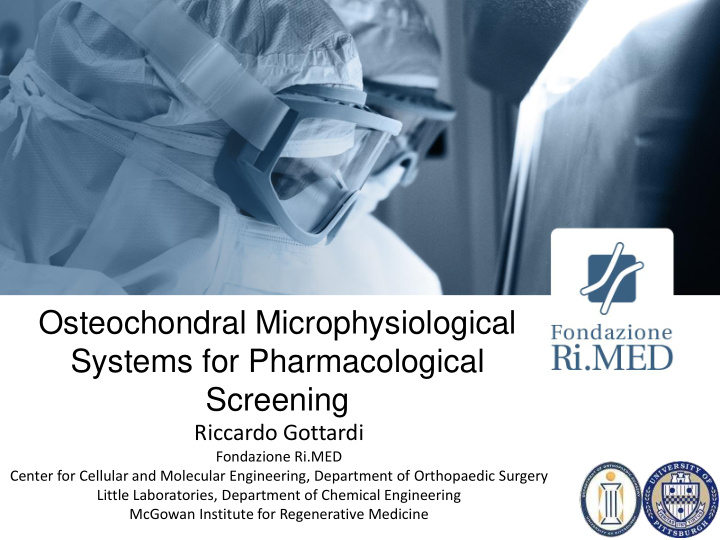



Osteochondral Microphysiological Systems for Pharmacological Screening Riccardo Gottardi Fondazione Ri.MED Center for Cellular and Molecular Engineering, Department of Orthopaedic Surgery Little Laboratories, Department of Chemical Engineering McGowan Institute for Regenerative Medicine
Microphysiological Systems and Personalized Medicine 3D Microphysiological Systems 2 Modified from D.A. Robinton & G.Q. Daley, Nature (2012) 481, 295 – 305
DARPA – NIH “human on a chip” program credit image: Griffith Lab/Draper Osteochondral Homo chipiens 3
Knee Osteoarthrites (OA) Modificato da http://www.willomd.com/
Osteoarthritis: Bone or Cartilage Disease? • Bone disease? - osteophytes - subchondral lesions - association with skeletal dysplasias • Cartilage disease? - relationship to cartilage injury - articular cartilage degeneration • Osteochondral disease! Development of an in vitro Osteochondral Microtissue Model to Study Pathogenesis and Screen Potential Treatments
Bottom Up vs Top Down Native tissue Bottom Up Top Down Micromass Cells seeded scaffolds Cartilage H&E Chondral construct Pellet culture Osseous construct Bone P.G. Alexander*, R. Gottardi*, H. Lin, T.P. Lozito, R.S. Tuan. 2014 Experimental Biology and Medicine
Osteochondral Microphysiological System (OC MPS) medium 1 Non Provisional patent No. 61/868,979 Provisional patent filed October 6 th , 2015 medium 2 a. Lid b. Insert c. O-ring d. Tissue/Construct 1 e. Tissue/Construct 2 7 Lozito TP, Alexander PG, Lin H, Gottardi R , Cheng AW, Tuan RS. 2013 Stem Cell Res Ther.
Simplified Bioreactor Design Lid Insert Well Base 8
Example of fluidic (empty insert) 9
Minimal mixing also with gelatin constructs (cell-free) IL-1 β Fluorescent proteing Trypsin inhibitor (21 kD) – Alexa Fluor 488 BSA (65 kD) – Alexa Fluor 555
Tissue engineering within the OC-MPS Mesenchymal stem cells (MSCs) seeded in photocrosslinkable gelatin 10% gelatin, 1% hyaluronic acid, 0.15% LAP 10% gelatin, 0.5% hydroxyapatite, 0.15% LAP H Lin, AW Cheng, PG Alexander, AM Beck, RS Tuan. 2014 Tissue Engineering Part A 11 H Lin, TP Lozito, PG Alexander, R Gottardi , RS Tuan. 2014 Molecular Pharmaceutics
Differentiation within the bioreactor (RT-PCR) “Cartilage” genes “Bone” genes 12
Histology H Lin, TP Lozito, PG Alexander, R Gottardi, RS Tuan. 2014 Molecular Pharmaceutics 13
Modelling osteochondral tissue response to the inflammatory signals of osteoarthritis 14
A model to study the pathogenesis of osteoarthritis IL1- β 15
Response of chondral construct (RT-PCR) “indirect” - IL-1 β to bone “direct” - IL-1 β to cartilage IL-1 β treatment (7dd) Decrease in anabolic genes. Increase in catabolic genes. Cartilage responds when bone is stressed. 16
Response of osseous construct (RT-PCR) “ direct ” - IL-1 β to bone “ indirect ” - IL-1 β to cartilage IL-1 β treatment (7dd) Decrease in anabolic genes. Increase in catabolic genes. Bone responds when cartilage is stressed. 17
Menstrual cycle hormones have a protective effect on the osteochondral unit 18
NIH - Women’s Health Initiative Estrogen vs. placebo group Estrogen + progestin vs. placebo group Higher bone mineral density Higher bone mineral density Lower risk of osteoporotic Lower risk of osteoporotic fracture fracture Reduced risk of hip OA No changes for hip OA No changes for knee OA No changes for knee OA Collaboration with Woodruff Group at Northwestern University
The effect of restoring menstrual cycle hormones on native osteochondral plugs All selected donors were post- menopausal women undergoing total knee replacement. Osteochondral plugs were explanted from macroscopically asymptomatic regions of the joint. test conditions Donors age 0/0 64 70 58 56 hormones/0 64 70 58 56 0/hormones 64 70 58 56 DAY -2 -1 0 1 2 3 4 5 6 7 8 9 10 11 12 13 14 15 16 17 18 19 20 21 22 23 24 25 26 27 MediaGrowth 1nM Estradiol + 0.1nM Estradiol + 0.1nM Estradiol 1nM Estradiol media 10nM Progesterone 50nM Progesterone
Protective effect on cartilage of the deep/calcified zone bar = 25 µm
Protective effect against bone volume loss Day 1 Day 30 Day 1 Day 30 p < 0.12 22
Conclusions • We have successfully developed a medium/high throughput microphysiological platform for osteochondral testing of native or engineered tissues to test the effects of potential treatments. • The in vitro system mimics the clinically observed responses to osteoarthritis inflammatory stress signals. • We have observed evidence of biochemical communication between the two components, supporting the concept of osteoarthritis as an osteochondral disease. • Exposure to the hormonal sequence of the menstrual cycle has a protective effect against bone volume loss, markedly at the bone/cartilage interface. 23
Acknowledgements 24
Recommend
More recommend